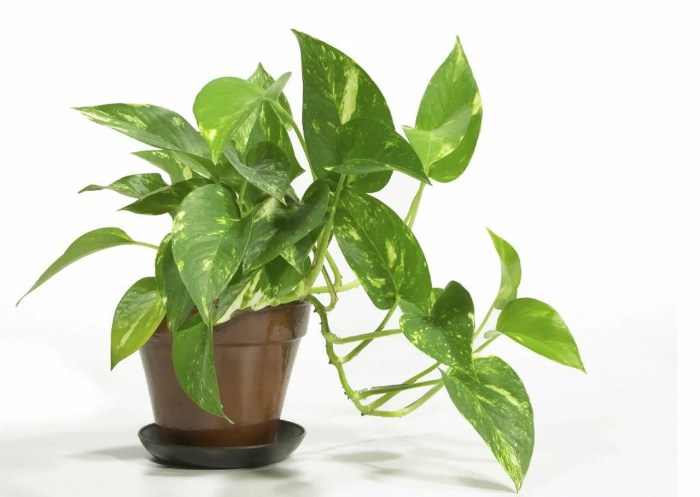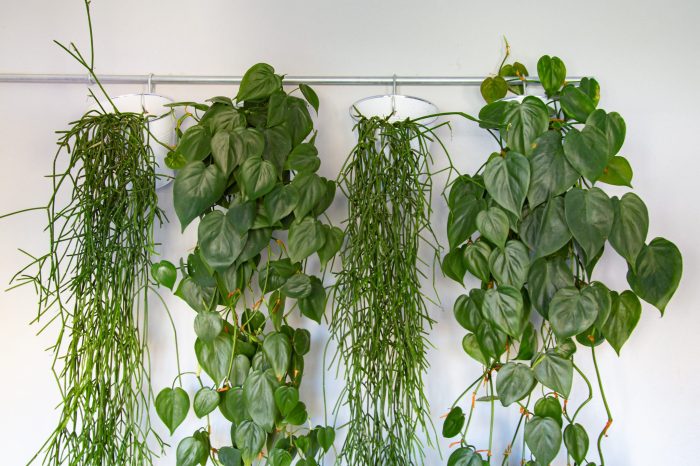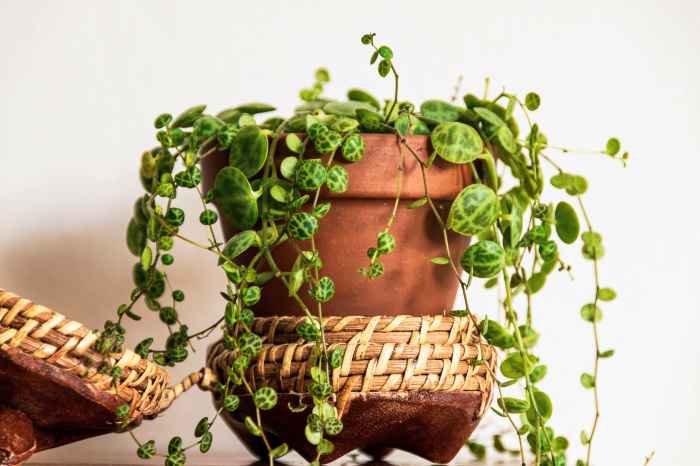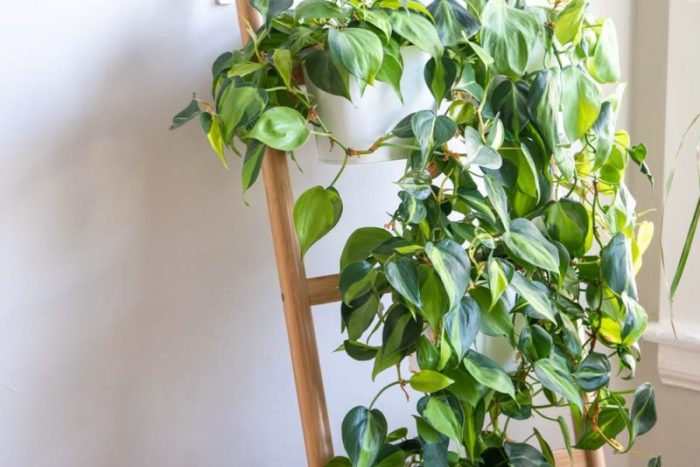Common trailing house plants, a captivating fusion of beauty and functionality, have become a beloved choice for home decorators and plant enthusiasts alike. These graceful vines, with their cascading foliage and air-purifying qualities, bring a touch of nature’s charm into any living space.
Their popularity stems from their ease of care, aesthetic appeal, and ability to improve air quality, making them a versatile addition to any home. Whether you’re a seasoned plant parent or a budding botanist, these trailing beauties are sure to enchant you.
Popular House Plants

Trailing house plants have become increasingly popular in recent years due to their versatility, aesthetic appeal, and air-purifying qualities. These plants can be used to add a touch of greenery to any room, and they can also help to improve air quality by removing toxins and pollutants.
Some of the most common trailing house plants include:
- Pothos( Epipremnum aureum): Pothos is a popular choice for trailing house plants because it is easy to care for and can tolerate a wide range of light conditions. It has heart-shaped leaves that come in a variety of colors, including green, yellow, and white.
- Philodendron( Philodendron hederaceum): Philodendron is another easy-care trailing house plant that is known for its large, glossy leaves. It can tolerate low light conditions and is a good choice for beginners.
- Spider plant( Chlorophytum comosum): Spider plants are known for their long, thin leaves that produce baby plants, or “spiderettes.” These plants are easy to care for and can tolerate a wide range of light conditions.
- String of pearls( Senecio rowleyanus): String of pearls is a unique trailing house plant that has long, thin stems that are covered in small, round leaves that resemble pearls. It is a slow-growing plant that prefers bright, indirect light.
- Burro’s tail( Sedum morganianum): Burro’s tail is a succulent trailing house plant that has long, trailing stems that are covered in plump, fleshy leaves. It prefers bright, indirect light and well-drained soil.
Trailing house plants are a great way to add a touch of greenery to any room. They are easy to care for and can tolerate a wide range of light conditions. They can also help to improve air quality by removing toxins and pollutants.
Common trailing house plants, such as ivy and pothos, are a popular choice for adding a touch of greenery to any room. However, if you’re looking for something a little more unique, consider best house plants hanging . These plants can add a touch of elegance and sophistication to any space, and they’re also relatively easy to care for.
Some of the best hanging plants include spider plants, ferns, and air plants.
Care and Maintenance
Common trailing houseplants require specific care and maintenance to thrive. Understanding their needs and providing the right environment is crucial for their health and appearance. Here’s a comprehensive guide to caring for these popular plants:
Proper care involves providing adequate watering, appropriate lighting, and regular fertilization. Additionally, troubleshooting common problems such as yellowing leaves, pests, and diseases is essential for maintaining healthy trailing houseplants.
Watering
Trailing houseplants have varying water requirements. Some, like spider plants and pothos, prefer moist soil, while others, like succulents and cacti, prefer drier conditions. Overwatering can lead to root rot, so it’s crucial to check the soil before watering and allow it to dry out slightly between waterings.
Lighting
Most trailing houseplants thrive in bright, indirect light. Direct sunlight can scorch their leaves, while low light can cause them to become leggy and lose their variegation. East- or west-facing windows are ideal for these plants.
Fertilization
Fertilizing trailing houseplants during their growing season (spring and summer) promotes healthy growth and flowering. Use a balanced liquid fertilizer diluted to half strength and apply it every two to four weeks. Avoid over-fertilizing, as this can damage the plants.
Trailing house plants are a popular choice for adding a touch of greenery to your home. They can be used to create a lush, cascading effect, and they are relatively easy to care for. If you’re looking for a way to add some life to your space, consider buying indoor hanging plants online . There are many different varieties of trailing house plants available, so you’re sure to find one that fits your style and needs.
Troubleshooting Common Problems
- Yellowing leaves:Can be caused by overwatering, underwatering, or nutrient deficiency.
- Pests:Aphids, mealybugs, and spider mites are common pests that can infest trailing houseplants. Treat with insecticidal soap or neem oil.
- Diseases:Root rot, caused by overwatering, is a common disease. Repot the plant into fresh soil and reduce watering frequency.
Propagation Methods
Trailing house plants can be propagated through various methods, each with its own advantages and suitability for specific species. These methods include stem cuttings, division, and layering, which allow gardeners to create new plants from existing ones, ensuring continuity and cost-effective expansion of their plant collection.
Stem Cuttings, Common trailing house plants
Stem cuttings involve taking a section of a healthy stem from the parent plant and rooting it to develop a new plant. This method is commonly used for trailing plants with flexible and non-woody stems. To propagate trailing plants using stem cuttings, follow these steps:
- Select a healthy stem that is several inches long and has at least two or three nodes (the points where leaves attach to the stem).
- Using a sharp, clean knife or pruning shears, cut the stem just below a node.
- Remove the leaves from the bottom inch or two of the stem.
- Dip the end of the stem in rooting hormone (optional, but can help promote root growth).
- Plant the stem in a well-draining potting mix, ensuring that the nodes are covered with soil.
- Keep the potting mix moist and provide bright, indirect light.
- Roots should develop within a few weeks, and new growth will appear from the nodes.
Division
Division is a method of propagation suitable for trailing plants that form clumps or have multiple rosettes. This method involves separating the plant into smaller sections, each with its own root system. To propagate trailing plants using division, follow these steps:
- Gently remove the plant from its pot and loosen the root ball.
- Using a sharp knife or spade, carefully divide the plant into sections, ensuring that each section has a portion of the root system.
- Replant the divisions in individual pots filled with fresh potting mix.
- Water the plants well and keep them in a warm, humid environment until new growth appears.
Layering
Layering is a propagation method that involves encouraging roots to develop on a stem while it is still attached to the parent plant. This method is particularly useful for trailing plants with long, flexible stems that can be bent or layered.
To propagate trailing plants using layering, follow these steps:
- Select a healthy stem and make a shallow incision or cut in the stem, just below a node.
- Pin the stem down to the soil surface using a wire or hairpin.
- Cover the incision with moist potting mix.
- Keep the potting mix moist and provide bright, indirect light.
- Roots should develop from the incision within a few weeks.
- Once the roots are well-established, cut the stem below the rooted portion and pot up the new plant.
Design Ideas

Trailing house plants add a touch of elegance and natural beauty to any home decor. Their cascading foliage can create a dramatic effect, adding height and visual interest to a room. There are endless ways to incorporate trailing house plants into your home, from hanging baskets to trellises and macrame hangers.
Hanging Baskets
Hanging baskets are a classic way to display trailing house plants. They can be hung from the ceiling, a hook on the wall, or even from a tree branch outdoors. When choosing a hanging basket, consider the size and weight of the plant.
You’ll also want to make sure the basket has drainage holes to prevent the plant from getting waterlogged.
Trellises
Trellises are a great way to add height and structure to your trailing house plants. They can be made from a variety of materials, including wood, metal, or PVC pipe. You can even make your own trellis using sticks or branches from your yard.
To use a trellis, simply train the plant’s stems to grow up the trellis. You can use twine or wire to secure the stems to the trellis.
Macrame Hangers
Macrame hangers are a stylish and bohemian way to display trailing house plants. They are made from knotted cords or yarn, and they can be hung from the ceiling or a wall. Macrame hangers come in a variety of sizes and styles, so you can find one that fits your home decor.
Health Benefits

Incorporating trailing house plants into your home environment offers a multitude of potential health benefits. These verdant additions can contribute to a healthier indoor atmosphere and enhance your overall well-being.
One significant benefit of trailing house plants lies in their ability to improve air quality. They act as natural air purifiers, effectively removing harmful pollutants and toxins from the air. This is particularly beneficial in homes with poor ventilation or those exposed to high levels of pollutants.
Stress Reduction
Studies have shown that the presence of plants in indoor spaces can have a calming effect on the mind. Interacting with plants, such as watering or simply observing their serene presence, has been linked to reduced stress levels and improved mood.
Common trailing house plants, such as pothos, ivy, and philodendron, add a touch of greenery and elegance to any indoor space. For a stylish and practical way to display these trailing plants, consider using ceramic hanging planters indoor . These planters are not only aesthetically pleasing but also provide excellent drainage and aeration for healthy plant growth.
By suspending trailing plants in ceramic hanging planters, you can create a vertical garden that adds a touch of nature and beauty to your home.
Mood Boost
Trailing house plants can contribute to a more positive and uplifting atmosphere in your home. Their vibrant greenery and delicate foliage can create a sense of tranquility and serenity, fostering a positive and calming ambiance.
Ultimate Conclusion

From the elegant Pothos to the charming String of Pearls, common trailing house plants offer a wide array of options to suit every taste and decor. With their minimal care requirements and stunning visual appeal, these plants are an investment in both beauty and well-being.
Embrace the lush greenery of trailing house plants and transform your home into a tranquil oasis.
Frequently Asked Questions: Common Trailing House Plants
What are the most common trailing house plants?
Pothos, String of Pearls, Spider Plant, Philodendron, and Ivy are some of the most popular trailing house plants.
How do I care for trailing house plants?
Trailing house plants generally require bright indirect light, well-draining soil, and moderate watering. Specific care instructions may vary depending on the plant species.
Can trailing house plants purify the air?
Yes, many trailing house plants, such as Pothos and Spider Plants, are known for their air-purifying abilities.